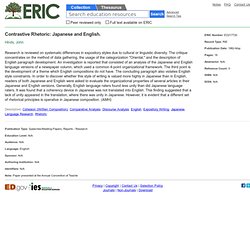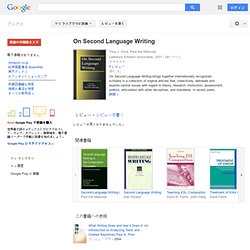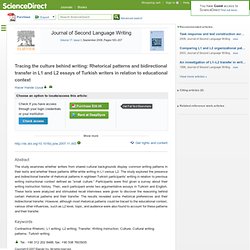

A Comparative Genre Analysis of Hedging Expressions in Research Articles: Is Fuzziness Forever Wicked? A Comparative Genre Analysis of Hedging Expressions in Research Articles: Is Fuzziness Forever Wicked?

Biook Behnam, Amin Naeimi, Ali Darvishzade Abstract Scientific writers might not inevitably be exact, precise and explicit in expression, eschewing vulnerability to criticism and seeking acceptability form academia. The present study aimed at investigating the frequency, form and function of the multi-objective linguistic and rhetorical device of hedging in the discussion sections of 100 qualitative and quantitative research articles where appropriate expression of scientific claims is highly welcome.
As such, the taxonomy proposed by Hyland (1996) was applied in order to identify and classify the various hedge words, followed by an independent-samples t-test to compare the total number of hedging devices. Full Text: PDFDOI: 10.5539/ells.v2n2p20 Refbacks There are currently no refbacks. This work is licensed under a Creative Commons Attribution 3.0 License. Kishotenketsu: a literary genre to create thinkers, or does it matter? Japanese writers are trained in a literary technique called kishotenketsu that is entirely different in structure from stories written in the Western literary model with conflict and pronounced outcome.

In kishotenketsu the supporting points loop around the main point without creating a linear argument. The points are intended to only obliquely reference the main point, it is up to the reader to infer how this relates to the implied main thesis. There is no firm conclusion, only an ambiguous ending that might point to several possible outcomes. Untitled. Rhetorical Patterns in English and Japanese - FATHMAN - 2012 - TESOL Quarterly. Deviating from 'ki-sho-ten-ketsu.
Speak Up / Deviating from 'ki-sho-ten-ketsu' : The Language Connection : Features : DAILY YOMIURI ONLINE (The Daily Yomiuri): Speak Up / Deviating from 'ki-sho-ten-ketsu' Ian Willey Special to The Daily Yomiuri It makes for an awkward moment.

When introducing essay writing to my university students, I go into a little contrastive rhetoric. The English academic essay, I say, has a strict, legalistic organization, derived from the rhetorical tradition of the ancient Greeks: The writer makes a point (the thesis statement), provides evidence to support that point (the body paragraphs), and wraps up everything with a closing statement (the conclusion).
Paul Kei Matsuda. The notion of contrastive rhetoric--that writers tend to organize their texts in ways that reflect their linguistic, cultural or educational backgrounds--continues to fascinate teachers and researchers of second language writing.

Yet, this topic needs to be approached carefully. On the one hand, this notion has too often been accepted uncritically because of its intuitive appeal; on the other hand, it has also been uncritically rejected because of the danger of stereotyping that comes with any attempt to describe second language writers in terms of their backgrounds. Matsuda, P. K. Matsuda, P. K. response to Ying. Peer reviewed ERIC Number: EJ637349 Record Type: CIJE Publication Date: 2001.

[OTA] Coventry University - British Academic Written English Corpus (BAWE) Intercultural Pragmatics. Instructions for Authors Please submit your paper as an email attachment to ikecskes@albany.edu Personal data with the title, name, affiliation, email and postal address, and a short bio (50-70 words) should be submitted with the paper in a separate file.

The journal operates a blind peer review that takes approximately 3-4 months. Submissions are sent to 2-3 reviewers whose comments will be available to the authors after the review process. Every effort is made to respond to the authors in a timely manner. Abstract must be no more than one page summarizing the main points of the paper. An investigation of L1-L2 transfer in writing among Japanese univ. Xinghua, L. New Directions in Contrastive Rhetoric. Bradley, N. Kubuto, R. & Lehner, A., 2004. Taft et al. The Myth of the “Turn” in Contrastive Rhetoric. Contrastive Rhetoric: Japanese and English. Research is reviewed on systematic differences in expository styles due to cultural or linguistic diversity.

Contrastive rhetoric: Japanese and English : Text - Interdisciplinary Journal for the Study of Discourse. Japanese and English Rhetorical Strategies: A Contrastive Analysis. Literacy Across CulturesSeptember, 1997 1/2 Bern Mulvey Fukui University This presentation examines English and Japanese "preferred" rhetorical strategies as identified by Hinds (1980, 1983, 1984), Takemata (1976), Mulvey (1992), Ricento(1987) and Yutani (1977), among others.

Three Japanese strategies will be discussed: the "return to baseline theme," the "kishoutenketsu" approach, and the "tempura" or "quasi inductive" approach. Nice overview of contrastive rhetoric. Landmark Essays on Esl Writing - Tony J. Silva, Paul Kei Matsuda - Google Books. On Second Language Writing - Tony J. Silva, Paul Kei Matsuda - Google Books. Tony Silva is a Professor in the Department of English at Purdue University, where he directs and teaches courses in the Graduate Program in ESL and the ESL Writing Program.

He co-edited the Journal of Second Language Writing from 1992 to 2007 and has served as the co-host of the Symposium on Second Language Writing since 1998. He has co-edited four books, co-authored another, and published his work in such journals as the Annual Review of Applied Linguistics, College Composition and Communication, ELT Journal, Modern Language Journal, TESOL Quarterly, and Written Communication. Paul Kei Matsuda is Associate Professor of English at Arizona State University. Journal of Pragmatics - Cultural differences in the organization of academic texts: English and German. Journal of Second Language Writing - Tracing the culture behind writing: Rhetorical patterns and bidirectional transfer in L1 and L2 essays of Turkish writers in relation to educational context. Abstract.

Journal of Second Language Writing - Keiko Hirose. Comparing L1 and L2 organizational patterns in the argumentative. Ntrastive Rhetoric Revisited and Redefined - Clayann Gilliam Panetta - Google Books. The theory of contrastive rhetoric was first put forth by Robert Kaplan in the mid 1960s to explain the differences in writing and discourse between students who were native speakers of English and their international counterparts. Over the past three decades, contrastive rhetoric theory has been used primarily by linguists in language centers and involved in ESL teaching. As the number of international students in American universities has continued to grow, contrastive rhetoric has become increasingly relevant to all disciplines, and to rhetoric and composition in particular. This volume breaks important new ground in its examination of contrastive rhetoric in the exclusive context of composition.
With the inclusion of current research on multicultural issues, this collection is appropriate for all instructors in ESL writing, including teachers in rhetoric, composition, and linguistics. It can also be used as an advanced text for students in these areas. Writing in Multicultural Settings. Writing in Multicultural Settings Editor(s): Carol Severino, Juan C. Guerra, Johnnella E. Butler Pages: xi & 370 pp.